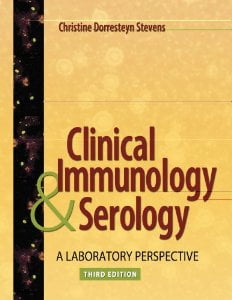Test Bank for Clinical Immunology and Serology A Laboratory Perspective, 3rd Edition: Stevens
$35.00 Original price was: $35.00.$26.50Current price is: $26.50.
Test Bank for Clinical Immunology and Serology A Laboratory Perspective, 3rd Edition: Stevens
Instant download Test Bank for Clinical Immunology and Serology A Laboratory Perspective, 3rd Edition: Stevens pdf docx epub after payment.

Product details:
- ISBN-10 : 080361814X
- ISBN-13 : 978-0803618145
- Author: F.A. Davis Company
This title is completely updated to include new information about the immune system and new treatments for immunological diseases! This practical introduction to clinical immunology covers all of the essential theoretical principles and the serology techniques most commonly used in the laboratory. Structured into easy-to-read, student-friendly sections, the 3rd edition focuses on the direct application of theory to clinical laboratory practice. The pedagogical structure for each chapter includes: chapter outlines; key terms; objectives; multiple-choice review questions with answer keys case studies; and, chapter summaries. Case studies make topics more relevant and help to explain the ‘big picture’. Each chapter is a complete learning module that contains theoretic principles, illustrations, definitions of relevant terminology, procedures for simulated clinical testing, and questions and case studies that help to evaluate learning. There is an insert that features full-color slides that visually demonstrate what to expect in the lab and show the relationship between immunology and hematology. Updated references and additional lab exercises reflect changes in immunology and serology. Lab exercises are designed to illustrate and reinforce principles discussed in the chapters.
Table of contents:
- Section 1. Nature of the Immune System
- Chapter 1. Introduction and Natural Immunity
- And Immunization
- Versus Humoral Immunity
- External Defense System
- Internal Defense System
- Acute-Phase Reactants
- Cellular Defense Mechanisms
- Phagocytosis
- Inflammation
- Summary
- Chapter 2. The Lymphoid System
- Primary Lymphoid Organs
- Bone Marrow
- Thymus
- Secondary Lymphoid Organs
- Spleen
- Lymph Nodes
- Other Secondary Organs
- Surface Markers On Lymphocytes
- Stages In B-Cell Differentiation
- Pro-B Cells
- Pre-B Cells
- Immature B Cells
- Mature B Cells
- Activated B Cells
- Plasma Cells
- T-Cell Differentiation
- Double-Negative Stage
- Double-Positive Stage
- Mature T Cells
- Antigen Activation
- Third Population Or Natural Killer Cells
- Mechanism of Cytotoxicity
- Antibody-Dependent Cell Cytotoxicity
- Laboratory Identification Of Lymphocytes
- Manual Method
- Summary
- Chapter 3. Nature of Antigens and the Major Histocompatibility Complex
- Factors Influencing The Immune Response
- Traits Of Immunogens
- Nature Of Epitopes
- Haptens
- Relationship Of Antigens To The Host
- Adjuvants
- Major Histocompatibility Complex
- Genes Coding for MHC Molecules (HLA Antigens)
- Structure of Class I Molecules
- Structure of Class Ii Molecules
- Role of Class I Molecules
- Role of Class Ii Molecules
- Clinical Significance of Mh
- Summary
- Chapter 4. Antibody Structure and Function
- Tetrapeptide Structure Of Immunoglobulins
- Cleavage with Papain
- Pepsin Digestion
- The Nature Of Light Chains
- Heavy Chain Sequencing
- Hinge Region
- Three-Dimensional Structure Of Antibodies
- IgG
- IgM
- IgA
- IgD
- IgE
- Antibody Diversity
- Ehrlich’s Side-Chain Theory
- Clonal Selection
- Genes Coding For Immunoglobulins
- Rearrangement of Heavy Chain Genes
- Light Chain Rearrangement
- Monoclonal Antibody
- Hybridoma Production
- Selection of Specific Antibody-Producing Clones
- Clinical Applications
- Summary
- Chapter 5. Cytokines
- Introduction To Cytokines
- Cytokines In The Innate Immune Response
- Interleukin-1 (Il-1)
- Tumor Necrosis Factor-
- Il-6
- Chemokines
- Tgf-ß
- Ifn-a and Ifn-ß
- Cytokines In The Adaptive Immune Response
- Th1 Cytokines
- Th2 Cytokines
- Cytokines Associated with T Regulatory Cells
- Erythropoietin And Colony Stimulating Factors
- Cytokines And Anticytokine Therapies
- Clinical Assays For Cytokines
- Summary
- Chapter 6. Complement System
- The Classical Pathway
- Recognition Unit
- Activation Unit
- The Membrane Attack Complex
- The Alternative Pathway
- The Lectin Pathway
- System Controls
- Regulation of the Classical and Lectin Pathways
- Regulation of the Alternative Pathway
- Regulation of Terminal Components
- Complement Receptors And Their Biological Roles
- Biological Manifestations Of Complement Activation
- Complement And Disease States
- Complement Deficiencies
- Major Pathway Components
- Regulatory Factor Components
- Laboratory Detection Of Complement Abnormalities
- Immunologic Assays of Individual Components
- Assays for the Classical Pathway
- Alternative Pathway Assays
- Interpretation of Laboratory Findings
- Complement Fixation Testing
- Summary
- Section 2. Basic Immunological Procedures
- Chapter 7. Safety and Specimen Preparation
- Biological Hazards
- Handwashing
- Personal Protective Equipment
- Procedure Precautions
- Biological Waste Disposal
- Transporting Patient Specimens
- Sharps Hazards
- Government Regulations
- Occupational Exposure to Bloodborne Pathogens
- Chemical Hazards
- General Precautions
- Material Safety Data Sheets
- Chemical Hygiene Plan
- Chemical Waste Disposal
- Radioactive Hazards
- General Precautions
- Radioactive Waste Disposal
- Serological Testing
- Specimen Preparation and Processing
- Simple Dilutions
- Compound Dilutions
- Summary
- Chapter 8. Precipitation Reactions
- Antigen–Antibody Binding
- Affinity
- Avidity
- Law of Mass Action
- Precipitation Curve
- Zone of Equivalence
- Prozone and Postzone
- Measurement Of Precipitation By Light Scattering
- Turbidimetry
- Nephelometry
- Passive Immunodiffusion Techniques
- Radial Immunodiffusion
- Ouchterlony Double Diffusion
- Electrophoretic Techniques
- Rocket Immunoelectrophoresis
- Immunoelectrophoresis
- Immunofixation Electophoresis
- Sources of Error in Electrophoresis
- Comparison Of Precipitation Techniques
- Summary
- Chapter 9. Agglutination
- Steps In Agglutination
- Sensitization
- Lattice Formation
- Enhancement of Lattice Formation
- Types Of Agglutination Reactions
- Direct Agglutination
- Passive Agglutination
- Reverse Passive Agglutination
- Agglutination Inhibition
- Coagglutination
- Antiglobulin-Mediated Agglutination
- Direct Antiglobulin Test
- Indirect Antiglobulin Test
- Instrumentation
- Quality Control And Quality Assurance
- Summary
- Chapter 10. Labeled Immunoassays
- Characteristics Of Labeled Assays
- Competitive versus Noncompetitive Assays
- Antibodies
- Standards or Calibrators
- Separation Methods
- Detection of the Label
- Quality Control
- Radioimmunoassay
- Competitive Binding Assays
- Advantages and Disadvantages of Radioimmunoassay
- Enzyme Immunoassay
- Heterogeneous Enzyme Immunoassay
- Rapid Immunoassays
- Homogeneous Enzyme Immunoassay
- Advantages and Disadvantages of Enzyme Immunoassay
- Fluorescent Immunoassay
- Direct Immunofluoescent Assays
- Indirect Immunofluoescent Assays
- Other Fluorescent Immunoassays
- Advantages and Disadvantages of Fluorescent Immunoassay
- Chemiluminescent Immunoassays
- Principle of Chemiluminescence
- Advantages and Disadvantages of Chemiluminescent Assays
- Summary
- Chapter 11. Molecular Diagnostic Techniques
- Characteristics Of Nucleic Acids
- Composition of DNA and RNA
- Replication of DNA
- Types of RNA
- Hybridization Techniques
- Solid Support Hybridization
- Solution Hybridization
- In Situ Hybridization
- DNA Chip Technology
- Drawbacks of Hybridization Techniques
- DNA Sequencing
- Target Amplification
- Polymerase Chain Reaction
- Transcription-Based Amplification
- Strand Displacement Amplification (SDA)
- Probe Amplification
- Signal Amplification
- Drawbacks Of Amplification Systems
- Future Of Molecular Diagnostic Techniques
- Summary
- Chapter 12. Flow Cytometry and Laboratory Automation
- Cell Flow Cytometry
- Principle
- Instrumentation
- Data Acquisition and Analysis
- Sample Preparation
- Clinical Applications
- Immunoassay Automation
- Validation
- Summary
- Section 3. Immune Disorders
- Chapter 13. Hypersensitivity
- Type I Hypersensitivity
- Triggering of Type I Reactions by IgE
- Role of Mast Cells and Basophils
- Mediators Released from Granules
- Clinical Manifestations of Immediate Hypersensitivity
- Treatment of Immediate Hypersensitivity
- Testing for Immediate Hypersensitivity
- Type II Hypersensitivity
- Transfusion Reactions
- Hemolytic Disease of the Newborn
- Autoimmune Hemolytic Anemia
- Type II Reactions Involving Tissue Antigens
- Testing for Type Ii Hypersensitivity
- Type III Hypersensitivity
- Arthus Reaction
- Serum Sickness
- Autoimmune Diseases
- Testing for Type Iii Hypersensitivity
- Type IV Hypersensitivity
- Contact Dermatitis
- Hypersensitivity Pneumonitis
- Tuberculin-Type Hypersensitivity
- Testing for Delayed Hypersensitivity
- Summary
- Chapter 14. Autoimmunity
- Systemic Lupus Erythematosus
- Clinical Signs
- Immunologic Findings
- Laboratory Diagnosis of Systemic Lupus Erythematosus
- Rheumatoid Arthritis
- Clinical Signs
- Immunologic Findings
- Laboratory Diagnosis of Rheumatoid Arthritis
- Treatment
- Autoimmune Thyroid Diseases
- Genetic Predisposition
- Clinical Signs and Immunologic Findings for Hashimoto’s Thyroiditis
- Clinical Signs and Immunologic Findings for Graves’ Disease
- Laboratory Testing for Autoimmune Thyroid Diseases
- Treatment for Autoimmune Thyroid Diseases
- Type I Diabetes Mellitus
- Immunopathology
- Laboratory Testing
- Treatment
- Other Diseases
- Multiple Sclerosis
- Myasthenia Gravis
- Goodpasture’s Syndrome
- Summary
- Chapter 15. Immunoproliferative Diseases
- Concepts Of Malignant Transformation
- Lymphomas
- Hodgkin’s Lymphoma
- Non-Hodgkin’s Lymphoma
- Lymphoblastic Leukemias
- Acute Lymphoblastic Leukemia
- Chronic Lymphoid Leukemia/Lymphoma
- Hairy Cell Leukemia
- Plasma Cell Dyscrasias
- Multiple Myeloma
- Waldenström’s Macroglobulinemia
- Role Of The Laboratory In Evaluating Immunoproliferative Diseases
- Immunophenotyping by Flow Cytometry
- Evaluation of Immunoglobulins
- Serum Protein Electrophoresis
- Immunofixation Electophoresis
- Evaluation of Genetic and Chromosomal Abnormalities
- Summary
- Chapter 16. Immunodeficiency Diseases
- Immunodeficiency Diseases
- General Observations
People also search:
Clinical Immunology and Serology A Laboratory Perspective
Clinical Immunology and Serology A Laboratory Perspective Stevens
Clinical Immunology and Serology A Laboratory Perspective Stevens 3rd
Clinical Immunology and Serology A Laboratory Perspective Stevens 3rd Test Bank
Test Bank for Clinical Immunology and Serology A Laboratory Perspective, 3rd Edition: Stevens Download
Related products
Test Bank
Test Bank for Operating Systems: Internals and Design Principles, 7th Edition: William Stallings











